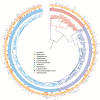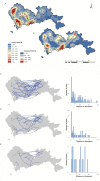Citywide Transmission of Multidrug-resistant Tuberculosis Under China's Rapid Urbanization: A Retrospective Population-based Genomic Spatial Epidemiological Study
- PMID: 31504306
- PMCID: PMC8127054
- DOI: 10.1093/cid/ciz790
Citywide Transmission of Multidrug-resistant Tuberculosis Under China's Rapid Urbanization: A Retrospective Population-based Genomic Spatial Epidemiological Study
Abstract
Background: Population movement could extend multidrug-resistant tuberculosis (MDR-TB) transmission and complicate its global prevalence. We sought to identify the high-risk populations and geographic sites of MDR-TB transmission in Shenzhen, the most common destination for internal migrants in China.
Methods: We performed a population-based, retrospective study in patients diagnosed with MDR-TB in Shenzhen during 2013-2017. By defining genomic clusters with a threshold of 12-single-nucleotide polymorphism distance based on whole-genome sequencing of their clinical strains, the clustering rate was calculated to evaluate the level of recent transmission. Risk factors were identified by multivariable logistic regression. To further delineate the epidemiological links, we invited the genomic-clustered patients to an in-depth social network investigation.
Results: In total, 105 (25.2%) of the 417 enrolled patients with MDR-TB were grouped into 40 genome clusters, suggesting recent transmission of MDR strains. The adjusted risk for student to have a clustered strain was 4.05 (95% confidence interval, 1.06-17.0) times greater than other patients. The majority (70%, 28/40) of the genomic clusters involved patients who lived in different districts, with residences separated by an average of 8.76 kilometers. Other than household members, confirmed epidemiological links were also identified among classmates and workplace colleagues.
Conclusions: These findings demonstrate that local transmission of MDR-TB is a serious problem in Shenzhen. While most transmission occurred between people who lived distant from each other, there was clear evidence that transmission occurred in schools and workplaces, which should be included as targeted sites for active case finding.The average residential distance between genomic-clustered cases was more than 8 kilometers, while schools and workplaces, identified as sites of transmission in this study, deserve increased vigilance for targeted case finding of multidrug-resistant tuberculosis.
Keywords: internal migrants; multidrug-resistant tuberculosis; spatial analysis; transmission; whole-genome sequencing.
© The Author(s) 2019. Published by Oxford University Press for the Infectious Diseases Society of America. All rights reserved. For permissions, e-mail: journals.permissions@oup.com.
Figures




Similar articles
-
High proportion of tuberculosis transmission among social contacts in rural China: a 12-year prospective population-based genomic epidemiological study.Emerg Microbes Infect. 2022 Dec;11(1):2102-2111. doi: 10.1080/22221751.2022.2112912. Emerg Microbes Infect. 2022. PMID: 35950916 Free PMC article.
-
Transmission of multidrug-resistant tuberculosis in Shimen community in Shanghai, China: a molecular epidemiology study.BMC Infect Dis. 2021 Oct 29;21(1):1118. doi: 10.1186/s12879-021-06725-0. BMC Infect Dis. 2021. PMID: 34715793 Free PMC article.
-
Transmission of multidrug-resistant tuberculosis in Beijing, China: An epidemiological and genomic analysis.Front Public Health. 2022 Nov 4;10:1019198. doi: 10.3389/fpubh.2022.1019198. eCollection 2022. Front Public Health. 2022. PMID: 36408017 Free PMC article.
-
Transmission of fluoroquinolones resistance among multidrug-resistant tuberculosis in Shanghai, China: a retrospective population-based genomic epidemiology study.Emerg Microbes Infect. 2024 Dec;13(1):2302837. doi: 10.1080/22221751.2024.2302837. Epub 2024 Jan 22. Emerg Microbes Infect. 2024. PMID: 38205528 Free PMC article.
-
Transmission of multidrug-resistant Mycobacterium tuberculosis in Shanghai, China: a retrospective observational study using whole-genome sequencing and epidemiological investigation.Lancet Infect Dis. 2017 Mar;17(3):275-284. doi: 10.1016/S1473-3099(16)30418-2. Epub 2016 Dec 3. Lancet Infect Dis. 2017. PMID: 27919643 Free PMC article.
Cited by
-
Genotypic and spatial analysis of transmission dynamics of tuberculosis in Shanghai, China: a 10-year prospective population-based surveillance study.Lancet Reg Health West Pac. 2023 Jun 29;38:100833. doi: 10.1016/j.lanwpc.2023.100833. eCollection 2023 Sep. Lancet Reg Health West Pac. 2023. PMID: 37790084 Free PMC article.
-
Multidrug-resistant Mycobacterium tuberculosis transmission in Shandong, China.Medicine (Baltimore). 2024 Mar 22;103(12):e37617. doi: 10.1097/MD.0000000000037617. Medicine (Baltimore). 2024. PMID: 38518003 Free PMC article.
-
High proportion of tuberculosis transmission among social contacts in rural China: a 12-year prospective population-based genomic epidemiological study.Emerg Microbes Infect. 2022 Dec;11(1):2102-2111. doi: 10.1080/22221751.2022.2112912. Emerg Microbes Infect. 2022. PMID: 35950916 Free PMC article.
-
Whole Genomic Analysis Revealed High Genetic Diversity and Drug-Resistant Characteristics of Mycobacterium tuberculosis in Guangxi, China.Infect Drug Resist. 2023 Aug 3;16:5021-5031. doi: 10.2147/IDR.S410828. eCollection 2023. Infect Drug Resist. 2023. PMID: 37554542 Free PMC article.
-
Transmission characteristics in Tuberculosis by WGS: nationwide cross-sectional surveillance in China.Emerg Microbes Infect. 2024 Dec;13(1):2348505. doi: 10.1080/22221751.2024.2348505. Epub 2024 May 15. Emerg Microbes Infect. 2024. PMID: 38686553 Free PMC article.
References
-
- McBryde ES, Meehan MT, Doan TN, et al. . The risk of global epidemic replacement with drug-resistant Mycobacterium tuberculosis strains. Int J Infect Dis 2017; 56:14–20. - PubMed
-
- World Health Organization. Global tuberculosis report 2018. Geneva: World Health Organization, 2018.
-
- Lalor MK, Casali N, Walker TM, et al. . The use of whole-genome sequencing in cluster investigation of a multidrug-resistant tuberculosis outbreak. Eur Respir J 2018; 51:1702313. - PubMed

